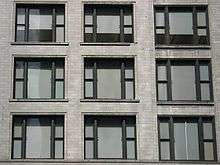Chicago window
A Chicago window is a large fixed glass panel flanked by two narrower sashes of the same height, filling a structural bay. The large pane is a single panel of plate glass, and the flanking elements are vertical double-hung sash windows with no dividing muntins. The fenestration was first used by architect Charles B. Atwood in the 1895 Reliance Building, and immediately after by Louis Sullivan at the 1899 Carson Pirie Scott department store, both in Chicago, Illinois. The window design was made possible by advances in glass-making technology and steel structural framing, and became a defining feature of the Chicago school style. The design offered both abundant natural light and practical ventilation.[1] Projecting oriel bays are a common variant of the Chicago window.

References
- Curl, James Stevens; Wilson, Susan (2016). Oxford Dictionary of Architecture. Oxford University Pres. p. 166. ISBN 978-0-19-967499-2.